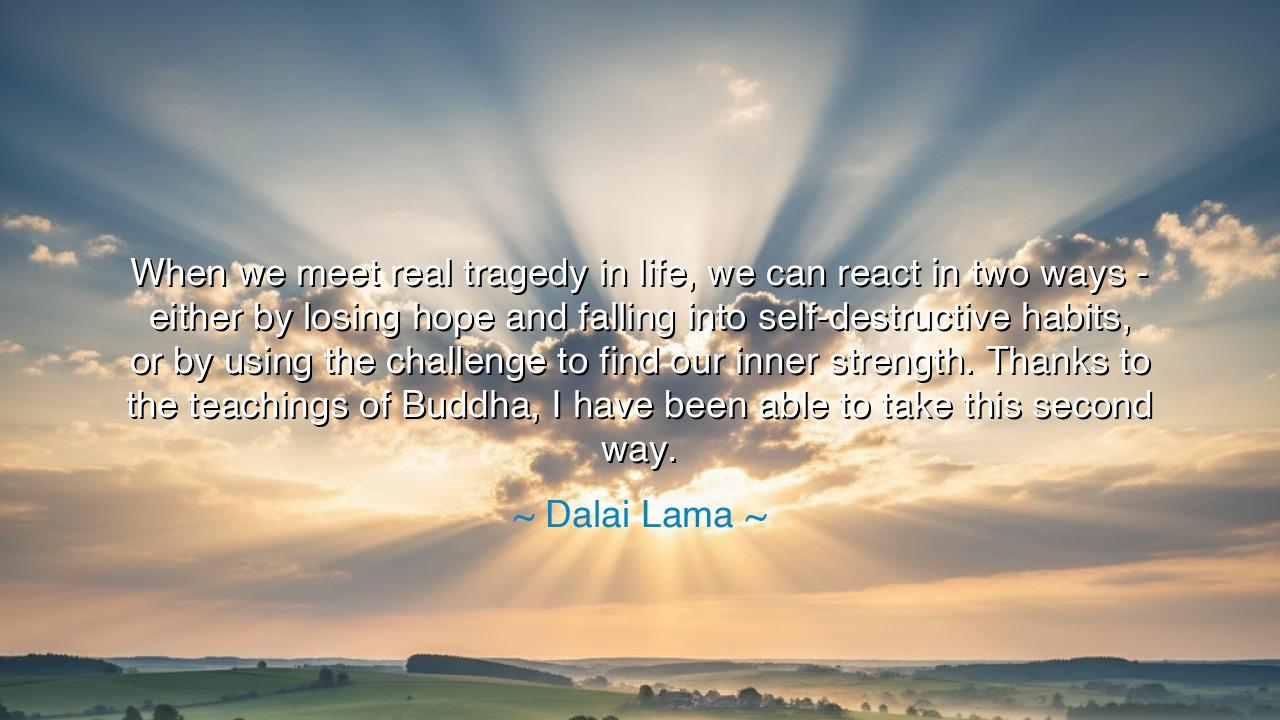
When we meet real tragedy in life, we can react in two ways -
When we meet real tragedy in life, we can react in two ways - either by losing hope and falling into self-destructive habits, or by using the challenge to find our inner strength. Thanks to the teachings of Buddha, I have been able to take this second way.






When the Dalai Lama said, “When we meet real tragedy in life, we can react in two ways—either by losing hope and falling into self-destructive habits, or by using the challenge to find our inner strength. Thanks to the teachings of Buddha, I have been able to take this second way,” he was not speaking from abstraction but from the deep wells of lived experience. His words flow from the heart of exile and the crucible of suffering—a wisdom forged not in comfort but in loss. He reminds us that tragedy is the great test of the human spirit, the storm that reveals whether we have built our inner temple upon sand or upon stone. Life, he says, does not spare anyone from sorrow; it only offers us a choice—despair or awakening.
The origin of this quote lies in the story of Tenzin Gyatso, the 14th Dalai Lama, who was forced to flee his homeland of Tibet in 1959 after the Chinese invasion. At the age of twenty-four, he left behind his country, his people, and the holy land of his ancestors, to live as a refugee in India. For most, such an event would have shattered the soul beyond repair. The loss of a homeland is not just the loss of soil—it is the loss of roots, memory, and belonging. Yet rather than surrender to hatred or grief, the Dalai Lama chose to turn inward, to seek strength in the timeless teachings of the Buddha, who taught that pain is inevitable, but suffering is optional. It is this inner strength, born of mindfulness and compassion, that transformed his tragedy into a mission of peace.
In these words lies a truth as old as the mountains: adversity reveals the true measure of the soul. When calamity strikes—when the heart is broken, the dream shattered, or the world stripped away—most men falter. Many drown in bitterness, clinging to anger as if it were strength. Others retreat into numbness, into distractions that promise relief but deliver only emptiness. This is the first way the Dalai Lama speaks of—the way of despair, which darkens the mind and corrodes the heart. Yet there is another way, the harder path—the path of acceptance, where pain becomes a teacher, and loss becomes the forge of resilience. It is not the path of escape, but of transformation.
The Dalai Lama’s teaching echoes the Buddhist understanding of dukkha, the suffering inherent in life. The Buddha, too, faced tragedy—not through the loss of land, but through the discovery that even pleasure and joy are fleeting. From this revelation came the Four Noble Truths, which teach that while suffering is universal, it can be transcended through wisdom, compassion, and right understanding. Thus, when the Dalai Lama speaks of finding “inner strength,” he refers to the strength born from this awareness—the unshakable peace that comes when one no longer fights against life’s impermanence, but flows with it. To find such peace is to be unbreakable, even in exile.
History offers many who have chosen this same path of inner mastery. Consider Nelson Mandela, who spent twenty-seven years imprisoned, his youth and freedom stolen. Yet from behind prison walls, he learned to rule not over nations but over himself. Like the Dalai Lama, Mandela refused to let hatred define him; instead, he cultivated forgiveness as a weapon of moral strength. When released, he emerged not embittered but enlightened, leading his people not into vengeance, but into reconciliation. Such men teach us that true victory lies not in the conquest of others, but in the conquest of the self.
In the Dalai Lama’s gentle wisdom, there is also an invitation to each of us. Every soul will one day meet its own tragedy—perhaps not the loss of a country, but the loss of a loved one, a dream, a purpose. When that day comes, we too must choose which path we will walk. Will we sink beneath the weight of despair, or will we rise and turn pain into insight? His teaching is not one of avoidance, but of transformation: he calls us to turn our suffering into compassion for others, to let empathy grow where bitterness could have taken root. This is how wounds become wisdom, and grief becomes grace.
So, my children of the fleeting world, let this be the lesson you carry forward: tragedy is not the end of life, but the beginning of understanding. Do not flee from sorrow—sit with it, listen to it, let it teach you patience, humility, and empathy. In moments of despair, remember that even the lotus blooms from the mud, and that the heart, when broken open, can shine brighter than before. Take refuge not in anger, but in awareness; not in destruction, but in the quiet strength of hope. For as the Dalai Lama has shown, when tragedy comes—and it will—it can either destroy you or awaken you. The choice, as ever, lies within.






AAdministratorAdministrator
Welcome, honored guests. Please leave a comment, we will respond soon